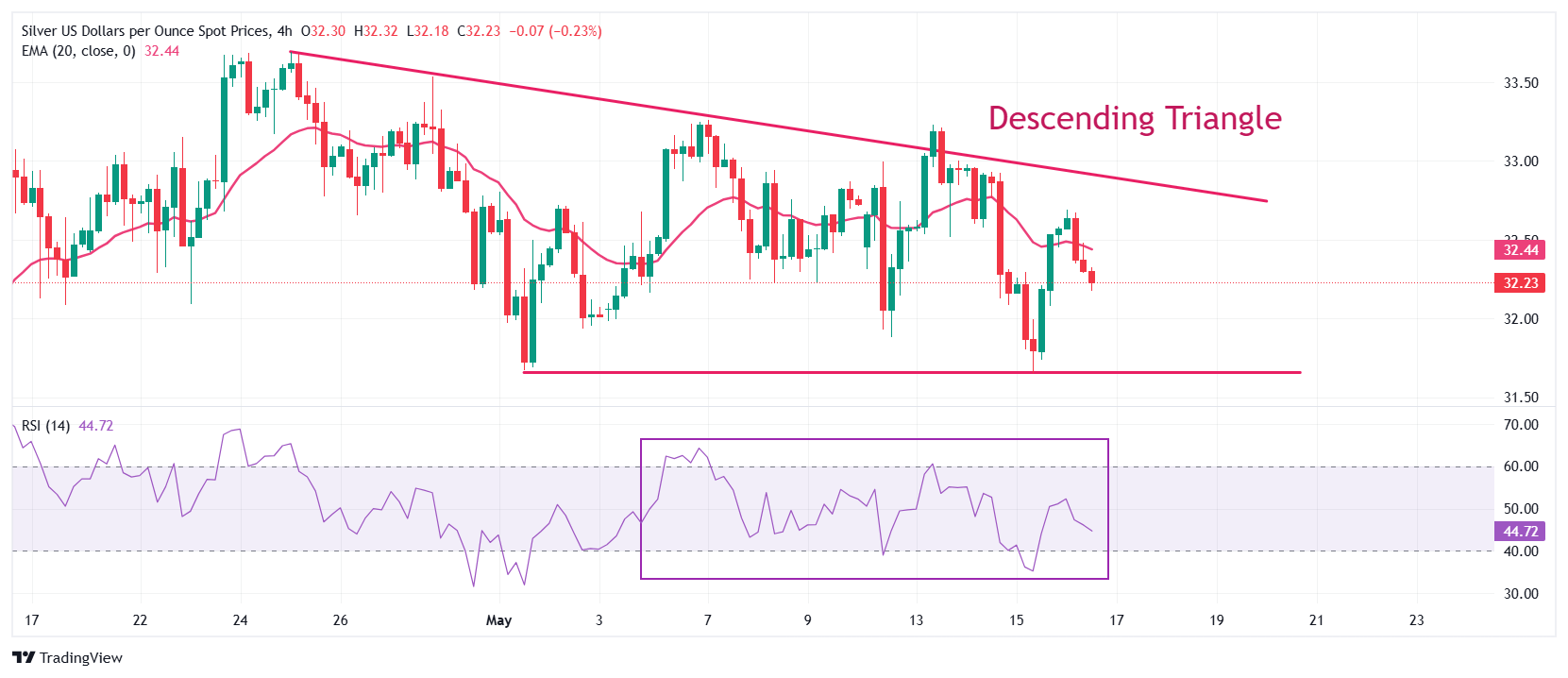- Silver price tumbles to near $32.30 on optimism about a potential trade deal between the US and China.
- This week, the US and China agreed to lower tariffs by 115%.
- Soft US economic data has weighed heavily on US Treasury yields.
Silver price (XAG/USD) falls sharply to near $32.30 during European trading hours on Friday. The white metal is down over 1% as investors become increasingly confident about a trade deal between the United States (US) and China.
The White House has signaled that Washington will “conduct a series of negotiations” with Beijing to avoid “escalation in trade tensions”. “We are going into a series of negotiations with China to prevent escalation again,” US Treasury Secretary Scott Bessent said on Thursday.
Trade tensions between the US and China started receding after both nations agreed to lower tariffs by 115% for 90 days. The event forced market experts to revise their global growth projections on the upside.
Theoretically, the demand for safe-haven assets, such as Silver, declines in a calm market mood. However, the demand for Silver as an industrial product has increased, given that China is recognized as the major manufacturing hub of the world. The temporary trade truce between the US and China is expected to allow Chinese firms to return to their prior capacity utilization. Silver as an industrial product is used in various sectors such as Electric Vehicles (EVs), electronics, and mining, etc.
The Silver price is lower despite a significant correction in US bond yields. 10-year US Treasury yields retrace sharply to near 4.40% from their monthly high of 4.55% posted on Thursday after the release of the soft US Producer Price index (PPI) and Retail Sales data for April.
Theoretically, the demand for non-yielding assets, such as the Silver price rises, when yields on interest-bearing assets decline.
Silver technical analysis
Silver price trades in a Descending Triangle formation on a four-hour timeframe. The chart pattern reflects indecisiveness among market participants. The near-term trend of the white metal is uncertain as it wobbles around the 20-period Exponential Moving Average (EMA), which is close to $32.44.
The 14-period Relative Strength Index (RSI) oscillates inside the 40.00-60.00 range, indicating a sideways trend.
Looking up, the March 28 high of $34.60 will act as key resistance for the metal. On the downside, the April 11 low of $30.90 will be the key support zone.
Silver four-hour chart

their
Silver FAQs
Silver is a precious metal highly traded among investors. It has been historically used as a store of value and a medium of exchange. Although less popular than Gold, traders may turn to Silver to diversify their investment portfolio, for its intrinsic value or as a potential hedge during high-inflation periods. Investors can buy physical Silver, in coins or in bars, or trade it through vehicles such as Exchange Traded Funds, which track its price on international markets.
Silver prices can move due to a wide range of factors. Geopolitical instability or fears of a deep recession can make Silver price escalate due to its safe-haven status, although to a lesser extent than Gold’s. As a yieldless asset, Silver tends to rise with lower interest rates. Its moves also depend on how the US Dollar (USD) behaves as the asset is priced in dollars (XAG/USD). A strong Dollar tends to keep the price of Silver at bay, whereas a weaker Dollar is likely to propel prices up. Other factors such as investment demand, mining supply – Silver is much more abundant than Gold – and recycling rates can also affect prices.
Silver is widely used in industry, particularly in sectors such as electronics or solar energy, as it has one of the highest electric conductivity of all metals – more than Copper and Gold. A surge in demand can increase prices, while a decline tends to lower them. Dynamics in the US, Chinese and Indian economies can also contribute to price swings: for the US and particularly China, their big industrial sectors use Silver in various processes; in India, consumers’ demand for the precious metal for jewellery also plays a key role in setting prices.
Silver prices tend to follow Gold’s moves. When Gold prices rise, Silver typically follows suit, as their status as safe-haven assets is similar. The Gold/Silver ratio, which shows the number of ounces of Silver needed to equal the value of one ounce of Gold, may help to determine the relative valuation between both metals. Some investors may consider a high ratio as an indicator that Silver is undervalued, or Gold is overvalued. On the contrary, a low ratio might suggest that Gold is undervalued relative to Silver.

